- ::. výukové programy
- ::. organizace, archivy
- ::. textarchiv
- ::. videoarchiv
- ::. projekty
- ::. diskusní fórum
- ::. sdílené plochy
- ::. profily
| 17. červenec 2008 | Santa Fe report |
Můj výlet do Santa Fe začal na vídeňském letišti 2. července před šestou ranní, kdy jsem autobusem dorazila z Prahy, vyzbrojená nahrávacími přístroji, a bylo docela působivé, když jsem se následující den večer ocitla v Albuquerqe, po dvou přestupech, v Paříži a v Atlantě. Z Air France jsem sledovala mraky a pak filmy na malém monitoru na zadní straně sedadla. První byl o šéfkuchařce, kterou zajímalo jen vaření, až do té doby, kdy potkala šaramantního specialistu na italské jídlo; v nejlepším se ale zasekl v přehávači. Druhý film byl milostný příběh dvou lidí vyskytujících se na stejném místě v prostoru, ale v odlišných místech v čase.
Úředník, který se mnou mluvil před vstupem na americké území, se dokonce pokoušel žertovat, stejně jako dva chlapci, co se starají o doručená zavazadla, byli moc vtipní, tvrdili mi, že nemluví anglicky, jen japonsky, a nechtěli mi nic říct. Když jsem v Atlantě čekala na přestup, koupila jsem si knížku o tom, jak porozumnět filozofii prostřednictvím vtipů od paní, která měla visačku s nápisem „be a shining star in customer service“, a která mi popřála, ať si užiju 4. červenec. Takže mi došlo, že jsem vlastně přiletěla na tenhle kontroverzní americký svátek, Independence Day. Téměř jsem už zapomněla, jak zábavné je pozorovat americký život; vše tu působí tak trochu chaoticky, jakoby neustále improvizovali, ale kupodivu nakonec všechno nějak funguje (až si člověk říká, „jak jen může taková země vůbec existovat a lidem se v ní dobře dařit“).
Když jsem po víc než 24 hodinách konečně dorazila do Albuquerque, bylo už po deváté večer, tak mi nezbývalo než vzít si taxíka do hostelu. Hostel Route 66 je skvělé místo na Central Avenue, umístěné přímo mezi Downtownem a Old Townem, jeden z těch hostelů, kde máte jídlo a pití zadarmo a ráno musíte pomoci s uklízením. Už z letadla jsem viděla město obklopené horami, a potom cestou dřevěné domky s terasami, a pak jsem velice rychle usnula na posteli pod velkou malbou s plachetnicí na rozbouřeném moři.
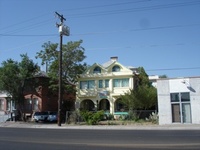
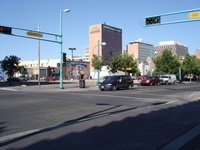
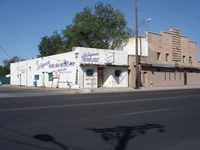
Další den jsem se šla podívat na město a odpoledne odjela autobusem do Santa Fe. Všude okolo hory a skály pokryté keříky, krása. Shluky mraků mi připomínaly kameny, které jsem ráno viděla v Museum of Natural History and Science. Santa Fe je ostatně město, kde se studuje komplexita /"Irreversibility and nonlinearity characterize phenomena in every field of science: the complexity of the markings on a butterfly's wings, a leopard's spots, the shape of a spleenwort fern, the whorls of a little green alga called the Mermaid's Cap, and the rhythms in living systems such as the palpitations of a heart, the firing of nerve cells within the brain and so on. Related, but more subtle, chaotic forms of complexity also arise from nonlinearity, including apparently random weather patterns, the outbreak of flu epidemics, and the spread of information and ideas.", In: P. Coveney and R. Highfield, Frontiers of Complexity/. Nad horami se začalo blýskat. Po příjezdu do Santa Fe jsem se vydala do hostelu, kde jsem bydlela už minule, a který jsem si zamilovala, bylo tam jen pár lidí tentokrát a nějaká dívka mi půjčila své kolo, tak jsem se po dešti stihla projet nahoru po Cerrillos Road, abych si nakoupila nějaké jídlo a pivo. Pak jsem zavolala Vasulkovým a ohlásila se na zítřek. Došla jsem k nim ráno pěšky, je to jen čtyři míle, a bylo to zábavné, protože si mě všichni podivně prohlíželi a stahovali okénka u svých aut, když jsem se blížila. I když tam nikdo pěšky nechodí, je tam docela hodně cyklistů, což je nedávný fenomén, tak jsem měla radost, že i v Santa Fe se kola pomalu stávají alternativním způsobem dopravy.
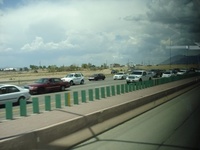
Hned první den ve Vasulkovic adobe ve „vesnici“ Agua Fria jsme s Woodym probrali situaci doma v Čechách, archívy i články a knížky, co mají být napsané, a diskuse pokračovaly i další dny. Natočila jsem asi šest hodin rozhovorů a snažila se projít co nejvíc věcí v archívu, včetně například videí Stephena Becka, filmů Jordana Belsona, videí a performancí Davida Stouta, přednášky Steiny a Woodyho ve Washington Public Library v 70. letech, záznamů performancí chicagského okruhu atp. Evidentně je naše formující se pražská skupina jedinou, která se vážně zaobírá vasulkovskými archívy, a je toho opravdu hodně, s čím se dá pracovat, jedinečný materiál, který by se měl postupně objevit na stránce aomoa.net:
1) materiály z výstavy Eigenwelt..., která se konala v rámci festivalu Ars Electronica v Linci v 90. letech (zatím na http://eigenwelt.zkm.de), by měly být zahrnuty do archívu a rozšířeny o video úryvky dokumentující vynálezce a jejich nástroje; celý materiál bylo možné spustit pomocí čárkových kódů v knize (po přejetí kódu speciálním perem se objevovaly obrázky, videa, další materiály); toto pero lze stále zakoupit a možná by stálo za to, nějak obnovit tuhle původní funkci
2) materiály z MindFrames, videa, texty, obrázky, dopisy atp., jejichž část je již v Praze (a byla představená na Open Archives 1), další část je na harddisku, který mi Woody věnoval naposledy, ale existuje spousta dalších materiálu dosud nezahrnutých, např. Sharitsovy pásky, dopisy a kresby (nikdy nepublikované), které nyní archivuje Jared Ashburn, jeden z teoretiků žijící v Santa Fe, učí na College of Santa Fe a má zájem o spolupráci
3) tzv. „Other Artists' Tapes“, neobyčejně bohatá kolekce, kterou Vasulkovi shromažďují od 60. let minulého století, většinou materiály, které jim věnovali další umělci; jedna z nejlepších sbírek experimentálního filmu a videa...dosud většinou na MiniDV (povedlo se mi shlédnout jen velmi malou část), Steina slíbila, že je zdigitalizuje a pošle postupně do Prahy...
Co se týče dalších archívů, s nimiž by se dalo spolupracovat, existuje archívní iniciativa Marcel Dona Foresty (teoretika a umělce z Paříže, který byl v Praze mj. na konferenci MutaMorphosis), www.mmmarcel.org, www.donforesta.net. Potřebuji zjistit víc informací o tom, jak archív funguje a o způsobech spolupráce.
Jon Cates, můj známý ze School of the Art Institute, vytváří archív na památku díla Phila Mortona, jedné z klíčových figur chicagského videa 70. let minulého století.
http://copyitright.worldpress.com
4) české a slovenské (a další středoevropské) filmy a videa, existuje plán založit soutěžní přehlídku místní experimentální produkce s „cenou Woodyho Vasulky“ (původně plánované na jihlavský dokumentární festival), tyto věci by se mohly stávat součástí archívu, tedy další kurátorovanou sekcí AoMoA
Klíčové tedy je, že nikdo jiný se o vasulkovské archívy nestará (a také jejich oficiální „fyzický“ archív v Langlois Fondation je ve špatné situaci, jelikož Daniel Langlois se rozhodl přestat nadaci podporovat), takže je to velká příležitost, které bychom se měli v Praze chopit. Máme důvěru a podporu a velikou zodpovědnost. Plán je, přes prázdniny zpřístupnit materiály online, nejprve pro skupinu kurátorů, kteří budou moci strukturu i materiály komentovat a přispívat k nim. Kromě výše zmíněných (Jared Ashburn, College of Santa Fe; Don Foresta, Marcel, Paříž; Jon Cates, School of the Art Institute; Gene Youngblood, Santa Fe taky Sherry Miller Hocking, Experimental TV Centre, pár dalších lidi ze střední a východní Evropy a snad se zapojí i studenti z FAMU.
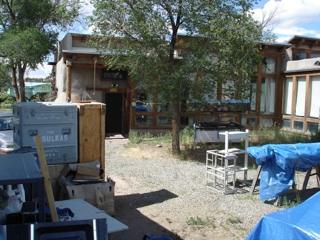
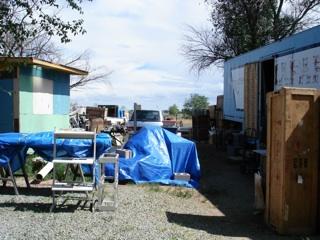
Dwelling - as well as being a term for a house, or for living somewhere, or for lingering somewhere - is a philosophical concept which was developed by Martin Heidegger. This approach to being-in-the-world, has, and is being, used in various branches of the social sciences to think about landscape, place and nature society relation. /wiki/
Dole úryvky z rozhovoru s Woodym o archívech a dalších věcech a jejich přepis:
Excerpts and transcriptions from the interview with Woody, Santa Fe, July 2008:
Woody on archives 1
I wanted to ask about the idea of archiving in your work, because you were from the beginning collecting everything you did and other artists' work and documenting everything you did, this is the idea of observation of what you do and documenting it at the same time which appears from the 1960s and now you are trying to make the archives and this is interesting because it is very special, I don't know many other artists who would have from the very beginning had the idea that they should collect and document everything and maybe now you have certain ideas what to do with that material, not only video but also that analogue instruments or tools?
It's not that hard to understand, because when I understood what the time and energy does, and when we already started, I am talking, this is the generational enterprise, it was like early film and it was generational effort made out of mainstream filmmaking, I understood this contribution of this particular generation in this particular time slot, especially when the analogue world breaks through into this digital domain, I understood that this was the historical, not historical but cultural historical, this is both. It was the historical meeting of the analogue world as we know it into the digital world which we don't really know but it's representing the reality and so I understood this was the pivotal movement or moment in the history and that's how I understood it and we both understood it, with Steina and many other people, that it's worth of our self-sacrifice.
So you have to say, O.K., there'll always be a Picasso here and there, because that's what they dialled by the muses that control our cultural life, and there were, like Bill Viola decided that he was the new Picasso, consciously, and of course Garry Hill was a divine, he was this young man that could understand and he, first his early works which I knew were magnificent but now their life and carrier is completely not interesting to me. In that place they contributed but they were not interested in the rest of the world, they were self-elected heros of the generation which they are.
But I come from this background of the Czech, even Moravian thinking about that this meeting with the history that's much more interesting than what you actually do in this kind of personal struggle to develop yourself into indispensably individual as artist. And anyway, what I do as archivist I still do it for the same purpose, I what to know, what's the commonality of that effort, which of these things that are living in the shadow in fact have a great significance. That's kind of the only ambition I have, that is more or less secretive because it's the curatorial treatment of these things that I am interested in and contextualizing these things, why they happened, again it becomes a different type of laboratory.
And I was always lucky and of course Steina always helped to this effort very significantly, to curate things, it's not the first time the last year that we would curate anything, we made certain curatorial work all our life, you know, since the Kitchen which was in a way titled Live Audience Testing Laboratory, which has both ends, you test the audience and test the laboratory. And then we made at least three or four shows that had this commonality, like Eigenwelt and this show and something in between, so this was in a way an impulse, it was actually more complicated than producing art; because producing art you can do it here on the table but to produce show is vastly complicated thing. But I like the complications because it's just the nature of my interest where is the boundary of an individual, how far you can go as an individual and how much you need the society or other people to mediate it.
And I experience both, one in the art where you can really take a sound source and produce composition of audio of some form, later you may not be educated, in video we had to go the whole generation thru process of education and that's one thing that painters go also thru, from childhood some, other in the middle of the life, but you have to learn some kind of a craft because there is no art without craft unless you are poet and then art and craft go thru your mind and it can be then spoken but the connection between your mind and the medium of the speech is enclosed in your own body, you don't even need to write it down.
Woody on archives 2
This was actually question about the archives, what's your ideal of the archive...
It's also some duty, my mother eventually wrote the history of the clan, of the families, and she went to archives and villages and churches and I understood that I inherited this but I am not so sure if she also got some inspiration from my work, because I mentioned that to her. But of course I take some pride in informing her about literature and poetry, cause she was just this what you would call the simple peasant girl that came with basic education to the world and then grew thru her, a lot had to do with her born-again incident, but she invented it into whole narrative way thru painting and writing. And she wrote that from the same source of duty. I don't know where that source of duty comes from, my sister didn't do it, my sister didn't any of that, so it must be something either some kind of rubbed zone, because me and my mother had very special relationship since childhood, our value system is total identical, including altruistic work for the public like her seeding some flowers next to the highway, and she would be telling about the truck drivers that go by from Turkey and everywhere to Prague, they should see some flowers on their long run on the the highway when they are sleeping half. And people would come to her saying, 'why do you do it mother, paní, proč to děláte, vždyť to nikdo nevidí tady', she would not relinquish the social service. So there is something strange about it, that I must admit.
I like to kind of waste my life in some kind of general purpose of life. And I love to be supported, I don't want to make money, I find it completely inappropriate, to live by sort of working. I think you live by being ornament on the body of society. And once they recognize you being an ornament, they help you to live. And that should be a good prescription for artist's life. But anyway, it's a different world.